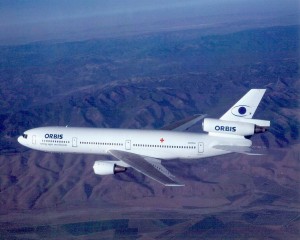
United Airlines, with the support of FedEx Corp., is donating a DC-10 Series 30 freighter to ORBIS International to replace its current DC-10 Flying Eye Hospital. The nonprofit development organization is dedicated to saving sight worldwide.
ORBIS International, a nonprofit development organization dedicated to saving sight worldwide, will replace its current DC-10 Flying Eye Hospital with a DC-10 Series 30 freighter. United Airlines, with the support of FedEx Corp., is donating the airplane to ORBIS. The $2 million donation is based on the plane’s estimated value and being funded equally by United and FedEx.
“Through the extraordinary generosity of United and FedEx, millions of people who would otherwise go blind or remain blind for lack of proper eye care will reap the rewards of advanced ophthalmic training,” said ORBIS Executive Director Geoffrey Holland. “The new aircraft will allow ORBIS to continue its mobile sight-saving training for 20 years. This is a truly wonderful gift to the world.”
At the heart of ORBIS is the world’s only Flying Eye Hospital—a DC-10 aircraft containing an innovative teaching facility and ophthalmic surgical center. Volunteer pilots from FedEx Express and United fly the ORBIS Flying Eye Hospital across the globe, and its international medical team conducts treatment and training programs. Leading eye surgeons volunteer their time to perform surgery and teach aboard the aircraft during programs specifically designed to suit the skill level of host countries.
United Airlines is the founding airline sponsor of ORBIS, having donated the first ORBIS Flying Eye Hospital, a DC-8, which was launched in 1982. In 1992, with donations from three individuals, ORBIS purchased a DC-10. In 1994, the ORBIS DC-8 was formally retired, and the ORBIS DC-10 took over as the world’s only flying eye hospital.
Until 2001, when it retired its fleet of DC-10 aircraft, United held the lead role in maintaining the current ORBIS Flying Eye Hospital. United currently supports ORBIS by transporting volunteer medical faculty and other personnel to ORBIS programs around the world. Over the years, more than 300 United pilots and maintenance crewmembers have donated their time and expertise to ORBIS.
“We’re pleased to continue our longstanding support of ORBIS and ensure that it can reach even more people across the world with this more efficient aircraft,” says Glenn Tilton, CEO of United Airlines. “Because of the important work of ORBIS, as well as our own employees who volunteer, there’s a great opportunity to make a significant difference in maintaining and restoring sight to people around the world.”
For more than 20 years, FedEx Express has played an indispensable role in helping ORBIS achieve its vision of a world in which no one is needlessly blind. Today, FedEx Express, which has the world’s largest fleet of DC-10s, is the leading aviation sponsor of the ORBIS Flying Eye Hospital. Without its donations of critically needed aircraft maintenance and overnight delivery services, the Flying Eye Hospital couldn’t fly and vital supplies couldn’t be delivered.
“FedEx is proud to play a role in helping make the next generation of Flying Eye Hospital a reality,” said Jim Parker, FedEx Express air operations senior vice president. “In helping ORBIS, FedEx is able to leverage our core aviation competencies to deliver the gift of sight worldwide.”
In 2006, FedEx renewed its sponsorship of the ORBIS DC-10, making it possible for ORBIS to operate the current Flying Eye Hospital at nominal expense.
After a comprehensive review of the Flying Eye Hospital’s navigation and engineering systems, ORBIS determined it had to replace its aging DC-10 as parts are becoming more difficult and expensive to obtain.
The DC-10 Series 30 freighter is about 10 years younger than ORBIS’s current aircraft, a McDonnell-Douglas DC-10-10 built in 1970, and has a flying life of at least 20 years. The new ORBIS Flying Eye Hospital will be more efficient, providing greater range, lower operating costs and better reliability.
A team, consisting of medical personnel, architects and engineers, has been assembled to determine the design and architectural modification necessary to convert the freighter into a state-of-the-art ophthalmic medical facility. The conversion of the plane is expected to take two years to complete.











